
Glacier National Park is part of a system of 43 parks and park reserves across Canada, and one of seven national parks in British Columbia. Established in 1886, the park encompasses 1,349 km2 (521 sq mi), and includes a portion of the Selkirk Mountains which are part of the larger grouping of mountains, the Columbia Mountains. It also contains the Rogers Pass National Historic Site.

A mountain hut is a building located high in the mountains, generally accessible only by foot, intended to provide food and shelter to mountaineers, climbers and hikers. Mountain huts are usually operated by an Alpine Club or some organization dedicated to hiking or mountain recreation. They are known by many names, including alpine hut, mountain shelter, mountain refuge, mountain lodge, and mountain hostel. It may also be called a refuge hut, although these occur in lowland areas too.

Garibaldi Provincial Park, also called Garibaldi Park, is a wilderness park located on the coastal mainland of British Columbia, Canada, 70 kilometres (43.5 mi) north of Vancouver. It was established in 1920 and named a Class A Provincial Park of British Columbia in 1927. The park is a popular destination for outdoor recreation, with over 30,000 overnight campers and over 106,000 day users in the 2017/2018 season.
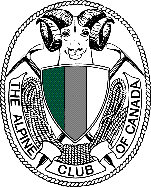
The Alpine Club of Canada (ACC) is an amateur athletic association with its national office in Canmore, Alberta that has been a focal point for Canadian mountaineering since its founding in 1906. The club was co-founded by Arthur Oliver Wheeler, who served as its first president, and Elizabeth Parker, a journalist for the Manitoba Free Press. Byron Harmon, whose 6500+ photographs of the Canadian Rockies in the early 20th century provide the best glimpse of the area at that time, was official photographer to the club at its founding. The club is the leading organization in Canada devoted to climbing, mountain culture, and issues related to alpine pursuits and ecology. It is also the Canadian regulatory organization for climbing competition, sanctioning local, regional and national events, and assembling, coaching and supporting the national team.

The Waputik Icefield is located on the Continental divide in the Canadian Rocky Mountains, in the provinces of British Columbia and Alberta. It is developed on the heights of the Waputik Range in the Central Main Ranges.

Arthur Oliver Wheeler was born in Ireland and immigrated to Canada in 1876 at the age of 16. He became a land surveyor and surveyed large areas of western Canada, including photo-topographical surveys of the Selkirk Mountains and the British Columbia-Alberta boundary along the continental divide through the Canadian Rockies. In 1906, he and journalist Elizabeth Parker were the principal founders of the Alpine Club of Canada (ACC). He was its first president, from 1906 to 1910, and editor of the Canadian Alpine Journal from 1907 to 1930. He remained Honorary President of the ACC from 1926 until his death in 1945. The Arthur O. Wheeler hut of the ACC is named after him.
Elizabeth Parker was a Canadian journalist in the early 1900s. She attended school in Truro, Nova Scotia, obtained her teaching certificate, married Henry John Parker at the age of 18, moved to Halifax, Nova Scotia and then to Winnipeg, Manitoba. She co-founded the Alpine Club of Canada in 1906 with Arthur Oliver Wheeler.
The Stanley Mitchell hut is an alpine hut located at an altitude of 2,060 metres (6,759 ft) in the Little Yoho Valley in Yoho National Park, British Columbia. It sits in a small meadow not far from the base of a mountain called The President. It serves as a base for hiking, scrambling, ski-touring and climbing the nearby mountains. The hut is maintained by the Alpine Club of Canada.

The Vice President is a mountain on The President/Vice President Massif just north of Emerald Lake in Yoho National Park, near the Alpine Club of Canada's Stanley Mitchell hut. The Vice President was named Mount McNicoll in 1904 by Edward Whymper after David McNicoll, the VP of the Canadian Pacific Railway. In 1907, the mountain was renamed by the Alpine Club of Canada, after it was discovered that the name had already been used on a mountain near Rogers Pass.
The Elk Lakes cabin is an alpine hut located between the French and Italian Military Groups in the Canadian Rockies. It resides near the Continental Divide in Elk Lakes Provincial Park, British Columbia. It is 62 km south of the Trans-Canada Highway in Kananaskis Country, Alberta and 104 km north of Sparwood, British Columbia. The area has hiking trails, and provides access to mountaineering objectives. In winter, ice climbs and skiing terrain with much powder abound. Elk Lakes terrain is similar to that near the Elizabeth Parker hut. The hut is maintained by the Alpine Club of Canada.
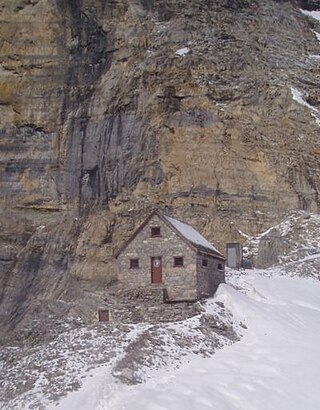
The Abbot Pass hut was an alpine hut located at an altitude of 2,925 metres (9,596 ft) in Abbot Pass in the Rocky Mountains in Alberta, Canada. It was nestled between Mount Victoria and Mount Lefroy, straddling the Great Divide, which, in this region, defines the boundary between Banff National Park in Alberta and Yoho National Park in British Columbia. While close to the border, the hut lay entirely in Banff National Park, and was the second-highest permanently habitable structure in Canada. The hut was maintained by the Alpine Club of Canada.
The Fay hut was an alpine hut located above Prospectors Valley in Kootenay National Park, British Columbia. Although the higher Neil Colgan hut superseded it as a base for climbs in the Valley of the Ten Peaks area, it still served as a convenient base for hikers and skiers doing day trips in the area, and as an overnight stop for mountaineers continuing on to the Neil Colgan hut. A new hut was built in 2005 to replace the original Fay hut, which was destroyed by a forest fire in 2003. The Fay hut was maintained by the Alpine Club of Canada (ACC).

The Bill Putnam hut is an alpine hut located in the Adamant range of the Selkirk mountains in British Columbia. It is set on a knoll at the edge of a high mountain meadow and provides access to a great array of mountaineering objectives, but is best known for its spectacular skiing terrain. The hut is maintained by the Alpine Club of Canada.

Glacier, which once comprised small communities, is on the western approach to Rogers Pass in southeastern British Columbia. The name derives from the Great Glacier, which in the 1880s was just over a mile from the original train station.
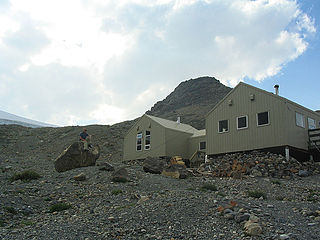
The Bow Hut is an alpine hut located at an elevation of 2,350 metres (7,710 ft) on the eastern edge of the Wapta Icefield in Banff National Park. It is the largest, best equipped, and most accessible of the four alpine huts on the Wapta Icefield, and serves as the base for a wide variety of ski tours and mountaineering ascents to half a dozen peaks on the Wapta. It is the easiest and safest starting point for the Wapta traverse; and Balfour Hut, the next hut on the traverse, can easily be reached from it in a day. It can also serve as an intermediate stop in a longer traverse which starts at the less easily accessible Peyto Hut. The hut is maintained by the Alpine Club of Canada.

Alpine club huts or simply club huts (Clubhütten) form the majority of the over 1,300 mountain huts in the Alps and are maintained by branches, or sections, of the various Alpine clubs. Although the usual English translation of Hütte is "hut", most of them are substantial buildings designed to accommodate and feed significant numbers of hikers and climbers and to withstand harsh high alpine conditions for decades.

The Illecillewaet Glacier is a glacier in British Columbia, Canada. It is located inside Glacier National Park in the Selkirk Mountains, a sub-range of the Columbia Mountains. After the construction of the Canadian Pacific Railway (CPR) near the glacier’s terminus, and the building of a hotel nearby, the glacier became a prominent tourist destination in the Canadian west. Easily accessible by road and railway, it is one of the most-studied glaciers in North America. Its retreat over the last one hundred years has been extensively documented.
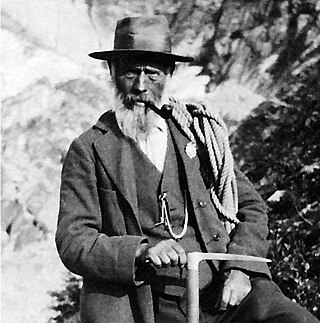
Peter Kaufmann was a Swiss mountain guide during the Silver Age of Alpinism (1865-1882) and the early twentieth century, who guided amateurs, experienced climbers, and several notables across glaciers, over mountain passes, and to the summits in the Swiss Alps, the Canadian Rockies, and the Selkirks.

Mount Bonney, is a 3,100-metre (10,200-foot) mountain summit located in Glacier National Park in the Selkirk Mountains of British Columbia, Canada. Mount Bonney is surrounded by ice including the Bonney Glacier, Clarke Glacier, Swanzy Glacier, and Bonney Névé. Its nearest higher peak is Mount Sir Donald, 10.0 km (6.2 mi) to the northeast. Mount Bonney is visible from Highway 1, the Trans-Canada Highway at Rogers Pass.
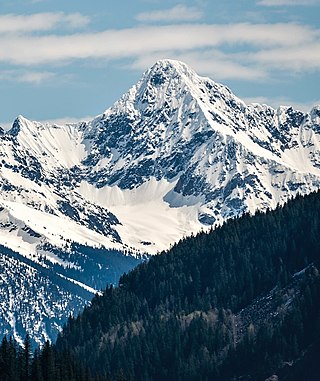
Albert Peak is a 3,045-metre (9,990-foot) mountain summit located in British Columbia, Canada.

















